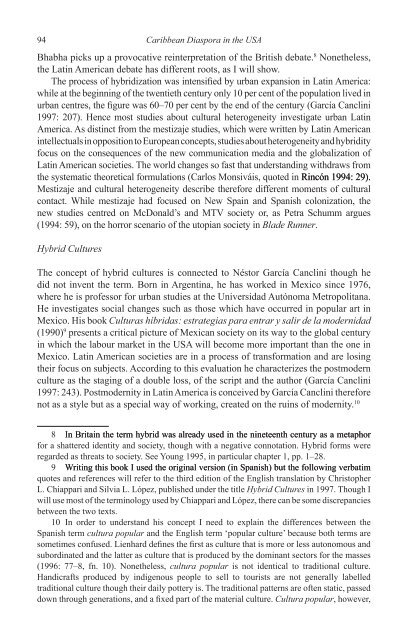You also want an ePaper? Increase the reach of your titles
YUMPU automatically turns print PDFs into web optimized ePapers that Google loves.
94<br />
<strong>Caribbean</strong> <strong>Diaspora</strong> <strong>in</strong> <strong>the</strong> <strong>USA</strong><br />
Bhabha picks up a provocative re<strong>in</strong>terpretation <strong>of</strong> <strong>the</strong> British debate. 8 None<strong>the</strong>less,<br />
<strong>the</strong> Lat<strong>in</strong> American debate has different roots, as I will show.<br />
The process <strong>of</strong> hybridization was <strong>in</strong>tensified by urban expansion <strong>in</strong> Lat<strong>in</strong> America:<br />
while at <strong>the</strong> beg<strong>in</strong>n<strong>in</strong>g <strong>of</strong> <strong>the</strong> twentieth century only 10 per cent <strong>of</strong> <strong>the</strong> population lived <strong>in</strong><br />
urban centres, <strong>the</strong> figure was 60–70 per cent by <strong>the</strong> end <strong>of</strong> <strong>the</strong> century (García Cancl<strong>in</strong>i<br />
1997: 207). Hence most studies about cultural heterogeneity <strong>in</strong>vestigate urban Lat<strong>in</strong><br />
America. As dist<strong>in</strong>ct from <strong>the</strong> mestizaje studies, which were written by Lat<strong>in</strong> American<br />
<strong>in</strong>tellectuals <strong>in</strong> opposition to European concepts, studies about heterogeneity and hybridity<br />
focus on <strong>the</strong> consequences <strong>of</strong> <strong>the</strong> new communication media and <strong>the</strong> globalization <strong>of</strong><br />
Lat<strong>in</strong> American societies. The world changes so fast that understand<strong>in</strong>g withdraws from<br />
<strong>the</strong> systematic <strong>the</strong>oretical formulations (Carlos Monsiváis, quoted <strong>in</strong> R<strong>in</strong>cón 1994: 29).<br />
Mestizaje and cultural heterogeneity describe <strong>the</strong>refore different moments <strong>of</strong> cultural<br />
contact. While mestizaje had focused on <strong>New</strong> Spa<strong>in</strong> and Spanish colonization, <strong>the</strong><br />
new studies centred on McDonald’s and MTV society or, as Petra Schumm argues<br />
(1994: 59), on <strong>the</strong> horror scenario <strong>of</strong> <strong>the</strong> utopian society <strong>in</strong> Blade Runner.<br />
Hybrid Cultures<br />
The concept <strong>of</strong> hybrid cultures is connected to Néstor García Cancl<strong>in</strong>i though he<br />
did not <strong>in</strong>vent <strong>the</strong> term. Born <strong>in</strong> Argent<strong>in</strong>a, he has worked <strong>in</strong> Mexico s<strong>in</strong>ce 1976,<br />
where he is pr<strong>of</strong>essor for urban studies at <strong>the</strong> Universidad Autónoma Metropolitana.<br />
He <strong>in</strong>vestigates social changes such as those which have occurred <strong>in</strong> popular art <strong>in</strong><br />
Mexico. His book Culturas híbridas: estrategias para entrar y salir de la modernidad<br />
(1990) 9 presents a critical picture <strong>of</strong> Mexican society on its way to <strong>the</strong> global century<br />
<strong>in</strong> which <strong>the</strong> labour market <strong>in</strong> <strong>the</strong> <strong>USA</strong> will become more important than <strong>the</strong> one <strong>in</strong><br />
Mexico. Lat<strong>in</strong> American societies are <strong>in</strong> a process <strong>of</strong> transformation and are los<strong>in</strong>g<br />
<strong>the</strong>ir focus on subjects. Accord<strong>in</strong>g to this evaluation he characterizes <strong>the</strong> postmodern<br />
culture as <strong>the</strong> stag<strong>in</strong>g <strong>of</strong> a double loss, <strong>of</strong> <strong>the</strong> script and <strong>the</strong> author (García Cancl<strong>in</strong>i<br />
1997: 243). Postmodernity <strong>in</strong> Lat<strong>in</strong> America is conceived by García Cancl<strong>in</strong>i <strong>the</strong>refore<br />
not as a style but as a special way <strong>of</strong> work<strong>in</strong>g, created on <strong>the</strong> ru<strong>in</strong>s <strong>of</strong> modernity. 10<br />
8 In Brita<strong>in</strong> <strong>the</strong> term hybrid was already used <strong>in</strong> <strong>the</strong> n<strong>in</strong>eteenth century as a metaphor<br />
for a shattered identity and society, though with a negative connotation. Hybrid forms were<br />
regarded as threats to society. See Young 1995, <strong>in</strong> particular chapter 1, pp. 1–28.<br />
9 Writ<strong>in</strong>g this book I used <strong>the</strong> orig<strong>in</strong>al version (<strong>in</strong> Spanish) but <strong>the</strong> follow<strong>in</strong>g verbatim<br />
quotes and references will refer to <strong>the</strong> third edition <strong>of</strong> <strong>the</strong> English translation by Christopher<br />
L. Chiappari and Silvia L. López, published under <strong>the</strong> title Hybrid Cultures <strong>in</strong> 1997. Though I<br />
will use most <strong>of</strong> <strong>the</strong> term<strong>in</strong>ology used by Chiappari and López, <strong>the</strong>re can be some discrepancies<br />
between <strong>the</strong> two texts.<br />
10 In order to understand his concept I need to expla<strong>in</strong> <strong>the</strong> differences between <strong>the</strong><br />
Spanish term cultura popular and <strong>the</strong> English term ‘popular culture’ because both terms are<br />
sometimes confused. Lienhard def<strong>in</strong>es <strong>the</strong> first as culture that is more or less autonomous and<br />
subord<strong>in</strong>ated and <strong>the</strong> latter as culture that is produced by <strong>the</strong> dom<strong>in</strong>ant sectors for <strong>the</strong> masses<br />
(1996: 77–8, fn. 10). None<strong>the</strong>less, cultura popular is not identical to traditional culture.<br />
Handicrafts produced by <strong>in</strong>digenous people to sell to tourists are not generally labelled<br />
traditional culture though <strong>the</strong>ir daily pottery is. The traditional patterns are <strong>of</strong>ten static, passed<br />
down through generations, and a fixed part <strong>of</strong> <strong>the</strong> material culture. Cultura popular, however,


















